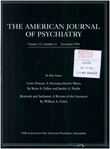Antisocial behavior of intravenous drug abusers: implications for diagnosis of antisocial personality disorder
Abstract
OBJECTIVE: A pattern of chronic adult antisocial behavior is not sufficient for the DSM-III-R diagnosis of antisocial personality disorder unless the early-onset criteria are satisfied, even if the adult criteria are met. The utility of the early-onset requirement for the diagnosis was examined in intravenous drug abusers, a population known to have high rates of irresponsible, aggressive, and criminal behavior. METHOD: The subjects were 237 drug abusers who had volunteered for an outpatient study of psychopathology and HIV risk behavior and infection. They completed a structured psychiatric interview as part of their participation in that study. The adult antisocial behavior of the group that met both the early-onset and the adult criteria for antisocial personality disorder, the group that met only the adult criteria, and the group that met neither the early-onset nor the adult criteria was then compared. RESULTS: Antisocial personality disorder (meeting the early-onset and adult criteria) was diagnosed in 44% of the sample; an additional 24% met only the adult criteria. The group with the diagnosis of antisocial personality disorder reported a more pervasive and more serious pattern of adult antisocial behavior than did the other groups, although antisocial behavior was commonplace in all three groups. CONCLUSIONS: Early onset of multiple antisocial behaviors identified a subset of drug abusers with important differences in the extent and severity of their adult antisocial behavior. The antisocial behavior of the group that met only the adult criteria suggests the possibility of a late-onset and less severe form of antisocial personality disorder.
Access content
To read the fulltext, please use one of the options below to sign in or purchase access.- Personal login
- Institutional Login
- Sign in via OpenAthens
- Register for access
-
Please login/register if you wish to pair your device and check access availability.
Not a subscriber?
PsychiatryOnline subscription options offer access to the DSM-5 library, books, journals, CME, and patient resources. This all-in-one virtual library provides psychiatrists and mental health professionals with key resources for diagnosis, treatment, research, and professional development.
Need more help? PsychiatryOnline Customer Service may be reached by emailing [email protected] or by calling 800-368-5777 (in the U.S.) or 703-907-7322 (outside the U.S.).



